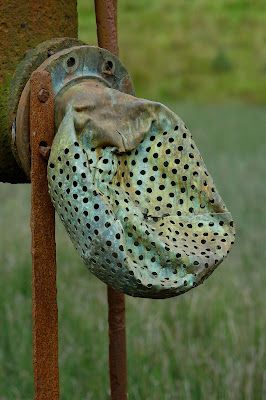On this walk I took the train from Dalmuir to Bowling and then walked up through the woods surrounding Overton House. I followed the woodland Eastwards from Rigangower to Little Round Top/Craigleith and Duntocher.
Light rain made the grass damp and soaked through my trousers. At the Lang Craigs I spotted a pair of Kestrels (Falco tinnunculus).
There was an incredible variety of colourful fungi and I have tried my best to photograph and identify them. Strangely, people here in the UK have a phobia of fungi and don't like to touch them, nevermind eat them. If any toadstools dare show their heads on a neatly clipped lawn they are quickly stamped on and eliminated! It seems in stark contrast to the continent, where (in many countries), people go mushroom collecting and a greater variety of mushrooms are to be encountered in the shops.
 |
| Armillaria sp.
|
Armillaria species, also known as honey fungi, are parasitic on their hosts and cause 'white rot' which kills healthy trees. These fungi are edible when cooked but should be eaten in small amounts as some specimens may cause stomach upsets.
 |
| Pink Waxcap (Hygrocybe calyptriformis)
|
The Pink Waxcap (Hygrocybe calyptriformis) has the waxy texture, bright colouration and conical, splitting-at-the-edges cap characteristic of many Hygrocybe. This grassland species has declined in numbers in recent years and is now labelled as at 'Low Risk' under the UK Biodiversity Action Plan. In terms of edibility, it is described as being 'edible but not worthwhile' (see Roger Phillip's 'Mushrooms' - an excellent book!). I photographed this specimen below the Lang Craigs, above Overton House.
Plenty of Birch Polypores (Piptoporus betulinus) in the narrow strip of birch forest stretching from Rigangower to the Hill of Dun. The fruiting bodies are too tough to be edible but are known to have antimicrobial and antiviral properties.
 |
| Birch Polypore (Piptoporus betulinus) young specimen
|
 |
| Birch Polypore (Piptoporus betulinus) older specimen
|
Between Auchentorlie Glen and Glenarbuck there is a small, shallow, unnamed reservoir with a collapsed platform and what looks like a metal water filter(?). The perforated nozzle of the filter was covered with oily-irridescent rust. Old abandoned man-made structures hold a special fascination for me!
Many vibrant-red Vermillion Waxcaps (
Hygrocybe miniata) were present on the grassland below Lang Craigs and near the river below the Test. This species is of unkown edibility (this is candy for the eyes only!).
 |
| Vermillion Waxcap (Hygrocybe miniata)
|
In the meadows below the Mohican woods there were a few lemon-yellow Hygrocybe vitellina.
The abdomens of gravid
Araneus quadratus females can be ridiculously plump and spherical - looking as though they've been inflated. There is much variation in colour: I have seen olive green and brick-red specimens. All individuals have the 4 distinctive white spots which give the species its scientific name (
quadratus means four,
Araneus means spider).


















